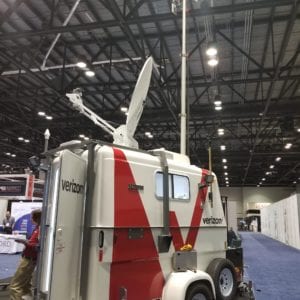ORLANDO, Fla.–The battle over public safety wireless customers has been joined. At this year’s International Wireless Communications Expo, Verizon defended its position as the market leader in providing service to first responders, while AT&T and partner FirstNet touted the potential and innovation that they aim to drive in the market.
Verizon had a significantly amplified presence compared to past years, with a large booth, a keynote address and a presence on a number of panels. AT&T, meanwhile, sponsored a FirstNet-related track for attendees to continue learning about what the two organizations are doing and their plans for the second year of the 25-year FirstNet contract.
How much of a threat is FirstNet to Verizon’s position? It’s a David-and-Goliath scenario at this point. Verizon has said that it serves about 70% of the nation’s first responders, while AT&T and FirstNet shared initial customer numbers and said that one year into their partnership, there are about 30,000 FirstNet connections from smartphones to in-vehicle modems. Coverage is one of the most often-cited reasons for public safety wariness when it comes to AT&T, and Verizon was quick to say that it covers 400,000 square miles more with LTE than AT&T.
“These networks take a lot of time and engineering and optimization to deliver,” Mike Maiorana, SVP public sector for Verizon told RCR Wireless News. “We’ve got a really good network, our customers trust it, and we intend to continue to have the best network so they continue to trust it.” He called Verizon’s lead on LTE coverage “a significant competitive differentiator” for Verizon during his keynote address at IWCE, and emphasized the carrier’s ongoing network investments as well as the potential for 5G to serve Verizon public safety customers.

Still, FirstNet has spent the last few years building relationships across all 56 states and territories to understand public safety customers’ needs and desires, and FirstNet does appear to be driving new competitiveness in the space. Band 14 devices are emerging, encompassing both Sonim’s ruggedized smartphones for first responders and commercial options such as the new Samsung Galaxy S9 devices. AT&T plans to touch about one-third of its cell sites this year to add Band 14 coverage, and leverage its retail store network to provide public safety customers easy access to FirstNet products. When FirstNet-AT&T announced a public-safety-specific core network (which is expected to be launched at the end of this month), Verizon followed suit. AT&T and FirstNet are developing an application ecosystem specifically for public safety, and Verizon jumped on that as well — prompting a number of concerns from IWCE participants about the extent to which apps will be interoperable across the two networks and whether prioritization and preemption will hold.
Both carriers also plan to introduce banks of deployable assets for emergency coverage that first responders can call upon prior to, or in the event of, a disaster or large event. AT&T-FirstNet said that its first deployables are being manufactured now and will be available shortly. Verizon’s “deployables as a service” will be available later this year, the carrier said, and showed off its new satellite-picocell on a trailer, or SPOT.
Chris Sambar, SVP for FirstNet-AT&T, said the partners have three goals for this year: get the core network up and running; build out Band 14 spectrum; and continue its education and adoption focus for potential customers. He said that the FirstNet core is utilizing some virtualization and will start out as a hybrid network and eventually move to full virtualization, as AT&T is doing with its commercial network.

